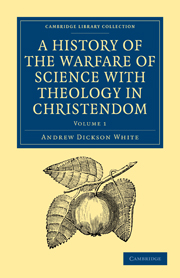Book contents
- Frontmatter
- INTRODUCTION
- Contents
- CHAPTER I FROM CREATION TO EVOLUTION
- CHAPTER II GEOGRAPHY
- CHAPTER III ASTRONOMY
- CHAPTER IV FROM “SIGNS AND WONDERS” TO LAW IN THE HEAVENS
- CHAPTER V FROM GENESIS TO GEOLOGY
- CHAPTER VI THE ANTIQUITY OF MAN, EGYPTOLOGY, AND ASSYRIOLOGY
- CHAPTER VII THE ANTIQUITY OF MAN AND PREHISTORIC ARCHÆOLOGY
- CHAPTER VIII THE “FALL OF MAN” AND ANTHROPOLOGY
- CHAPTER IX THE “FALL OF MAN” AND ETHNOLOGY
- CHAPTER X THE “FALL OF MAN” AND HISTORY
- CHAPTER XI FROM “THE PRINCE OF THE POWER OF THE AIR” TO METEOROLOGY
- CHAPTER XII FROM MAGIC TO CHEMISTRY AND PHYSICS
CHAPTER IV - FROM “SIGNS AND WONDERS” TO LAW IN THE HEAVENS
Published online by Cambridge University Press: 29 August 2010
- Frontmatter
- INTRODUCTION
- Contents
- CHAPTER I FROM CREATION TO EVOLUTION
- CHAPTER II GEOGRAPHY
- CHAPTER III ASTRONOMY
- CHAPTER IV FROM “SIGNS AND WONDERS” TO LAW IN THE HEAVENS
- CHAPTER V FROM GENESIS TO GEOLOGY
- CHAPTER VI THE ANTIQUITY OF MAN, EGYPTOLOGY, AND ASSYRIOLOGY
- CHAPTER VII THE ANTIQUITY OF MAN AND PREHISTORIC ARCHÆOLOGY
- CHAPTER VIII THE “FALL OF MAN” AND ANTHROPOLOGY
- CHAPTER IX THE “FALL OF MAN” AND ETHNOLOGY
- CHAPTER X THE “FALL OF MAN” AND HISTORY
- CHAPTER XI FROM “THE PRINCE OF THE POWER OF THE AIR” TO METEOROLOGY
- CHAPTER XII FROM MAGIC TO CHEMISTRY AND PHYSICS
Summary
THE THEOLOGICAL VIEW
Few things in the evolution of astronomy are more suggestive than the struggle between the theological and the scientific doctrine regarding comets—the passage from the conception of them as fire-balls flung by an angry God for the purpose of scaring a wicked world, to a recognition of them as natural in origin and obedient to law in movement. Hardly anything throws a more vivid light upon the danger of wresting texts of Scripture to preserve ideas which observation and thought have superseded, and upon the folly of arraying ecclesiastical power against scientific discovery.
Out of the ancient world had come a mass of beliefs regarding comets, meteors, and eclipses; all these were held to be signs displayed from heaven for the warning of mankind. Stars and meteors were generally thought to presage happy events, especially the births of gods, heroes, and great men. So firmly rooted was this idea that we constantly find among the ancient nations traditions of lights in the heavens preceding the birth of persons of note. The sacred books of India show that the births of Crishna and of Buddha were announced by such heavenly lights. The sacred books of China tell of similar appearances at the births of Yu, the founder of the first dynasty, and of the inspired sage, Lao-tse.
- Type
- Chapter
- Information
- A History of the Warfare of Science with Theology in Christendom , pp. 171 - 208Publisher: Cambridge University PressPrint publication year: 2009First published in: 1896



